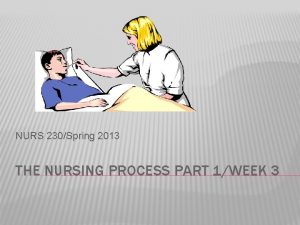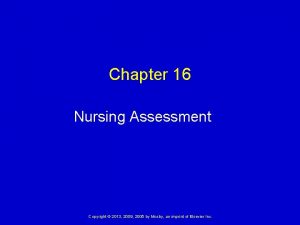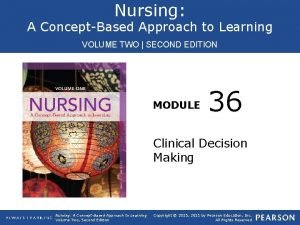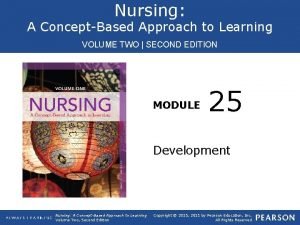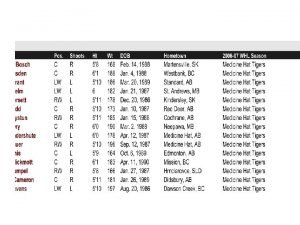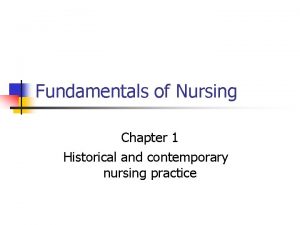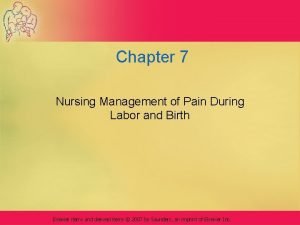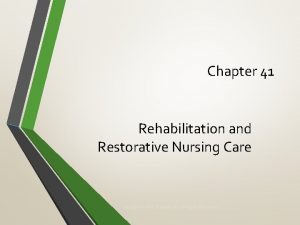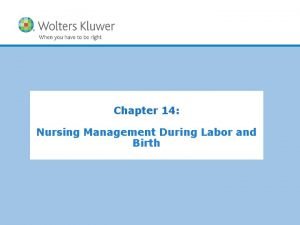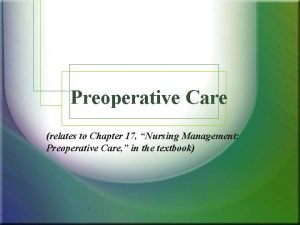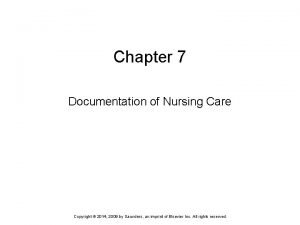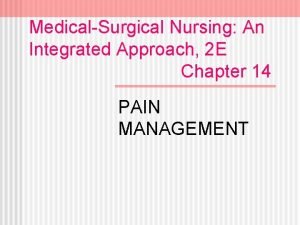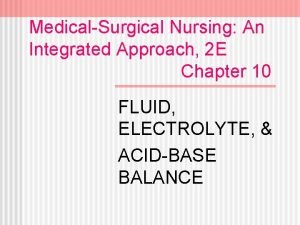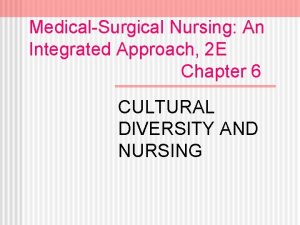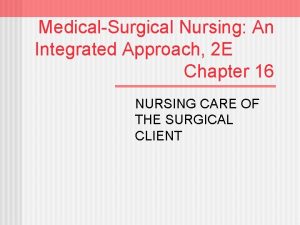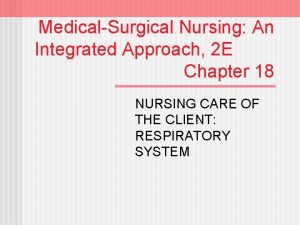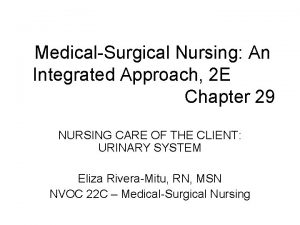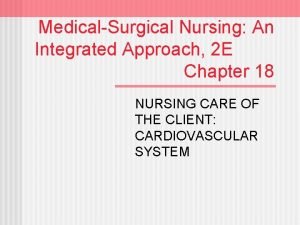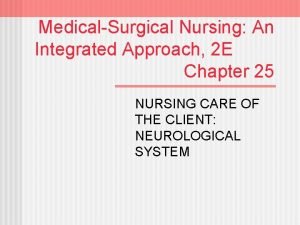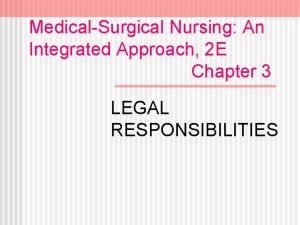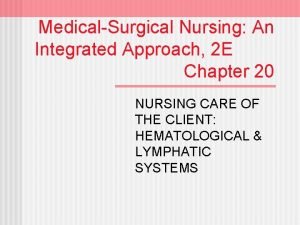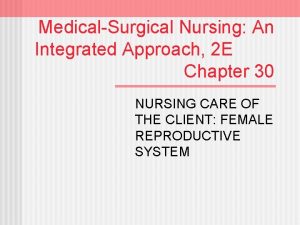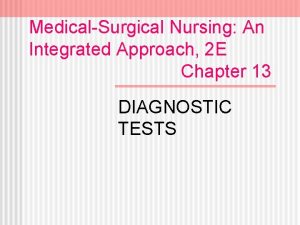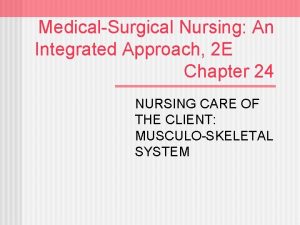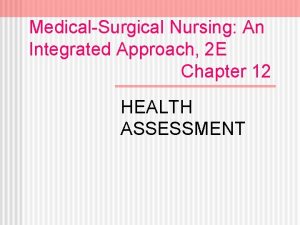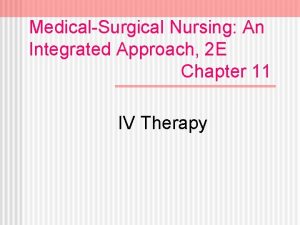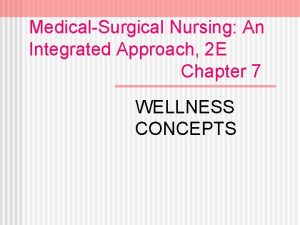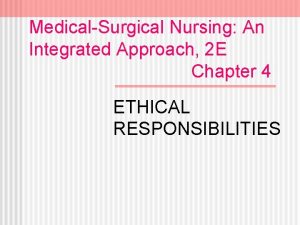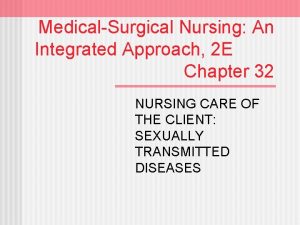MedicalSurgical Nursing An Integrated Approach 2 E Chapter





























- Slides: 29

Medical-Surgical Nursing: An Integrated Approach, 2 E Chapter 27 NURSING CARE OF THE CLIENT: ENDOCRINE SYSTEM

A Unique System The endocrine system is unique in that the components are not in direct physical contact but are scattered throughout the body. n Like the nervous system, it provides communication and control, but is slower and has longer lasting control, which it exerts through the secretion of hormones. n

Hormones Chemical substances that initiate or regulate activity of another organ, system, or gland in another part of the body. n The level of hormone in the blood is regulated by the homeostasis mechanism known as negative feedback. n

The Glands of the Endocrine System The pancreas. n The pituitary gland. n The hypothalamus. n The thyroid. n The parathyroid. n The adrenals. n

The Pancreas Raises blood glucose. n Lowers blood glucose. n Inhibits secretion of insulin, glucagon, and growth hormone. n

Antherior Pituitary n n n Stimulates thyroid growth and secretion of the thyroid hormone. Stimulates adrenal cortex growth and secretion of glucocorticoids. Stimulates growth. Stimulates breast development during pregnancy and milk secretion. Causes increase in synthesis and spread of melanin (pigment) in skin. Stimulates estrogen production; causes ovulation; stimulates progesterone and testosterone.

Posterior Pituitary Stimulates water retention by kidneys to decrease urine secretion. n Stimulates uterine contractions; causes breast to release milk into ducts. n

Thyroid Gland Increases metabolic rate. n Decreases blood calcium concentration. n

Parathyroid Gland n Increases blood calcium concentration.

Adrenal Cortex Stimulates gluconeogenesis and increases blood glucose; antiinflammatory; antiimmunity; antiallergy. n Regulates electrolyte and fluid homeostasis. n Stimulates sexual drive in females; in males, negligible effect. n

Adrenal Medulla n Prolongs and intensifies sympathetic nervous response to stress.

Assessment of the endocrine system can be challenging since the glands are scattered. n Negative findings are as important as positive findings. n

Diabetes Mellitus A disorder of metabolism which affects the production and secretion of insulin. n Insulin is a hormone produced and secreted by beta cells in the islets of Langerhans in the pancreas. It stimulates the active transport of glucose into muscle and adipose tissue cells, making it available for cell use. n

How Insulin Works

Hyperglycemia/Hypoglycemia A deficiency of insulin results in hyperglycemia (elevated blood glucose). n An excess of insulin results in hypoglycemia (low blood glucose). n

At-Risk for Diabetes n n n Anyone age 45 and older. Anyone, regardless of age, with one of the following risk factors: Obesity; immediate family member with diabetes; member of high-risk ethnic group (African-American, Hispanic. American, some Native American groups)/ Having a baby weighing more than 9 pounds. History of gestational diabetes mellitus. Hypertension. High-density lipoprotein level of 35 mg/d. L or less, or a triglyceride level of 250 mg/d. L or more.

Diabetic Control A coordinated program of exercise, diet, and medications is used to achieve diabetic control. n Persons with type 1 diabetes always require insulin therapy in addition to dietary control and exercise. Persons with type 2 diabetes are managed through diet and exercise and may or may not require oral hypoglygemic agents or insulin. n

Five Goals of Nutrition Therapy to Control Diabetes Mellitus Maintain as near-normal blood glucose level. n Achieve optimal serum lipid levels. n Provide adequate calories to maintain or attain a reasonable weight. n Prevent and treat acute complications of insulin-treated diabetes. n Improve overall health through optimal nutrition. n

Symptoms of Acute Complications of Diabetes: Hypoglycemia n Mild Hypoglycemia: n Diaphoresis. n Pallor. n Paresthesias. n Excess hunger. n Palpitations. n Tremors. n Anxiety. n §Severe Hypoglycemia: §Seizures. §Loss of consciousness. §Shallow respirations. Moderate Hypoglycemia: n Confusion, disorientation. n Slurred speech. n Behavior changes. n Irritability. Nursing Alert! Severe hypoglycemia is a medical emergency. Administer some form of glucose immediately.

Symptoms of Acute Complications of Diabetes: Hyperglycemia Hyperosmolar Nonketonic (HHNK) Syndrome Polyuria. n Polydipsia. n Skin hot, dry, decreased turgor. n Dehydration—hypotension, increased pulse. n Blurred vision. n Weakness. n Mental status changes, confusion to coma. n

Symptoms of Acute Complications of Diabetes: Diabetic Ketoacidosis (DKA) n Same as HHNK plus symptoms of acidosis: n “Fruity” odor to breath. n Kussmaul’s respirations (deep, nonlabored).

Chronic Complications of Diabetes Infections (include diabetic foot infections, boils, cellulitis, urinary tract infections, yeast infections. n Diabetic neuropathies. n Nephropathy (Chronic renal failure). n Retinopathy. n Vascular changes. n

Pituitary Disorders n Hyperpituitarism: n Gigantism: proportional overgrowth of all body tissues. n Acromegaly: bone thickening with transverse growth and tissue enlargement.

Pituitary Disorders n Hypopituitarism: a complex syndrome marked by metabolic dysfunction, sexual immaturity, and growth retardation. n Simmonds’ Disease: total absence of all pituitary secretions. n Diabetes insipidus: a deficiency of ADH.

Thyroid Disorders: Hyperthyroidism n A collective term for a condition marked by increased thyroid activity and overproduction of thyroid hormones thyroxine and triiodothyronine.

Thyroid Disorders: Hypothyroidism A condition in which the metabolic processes are decreased because of a deficiency of the thyroid hormone. n Hypothyroid conditions include cretinism, myxedema, and Hashimoto’s thyroiditis. n

Goiter n An enlargement of the thyroid unrelated to inflammation or neoplasm.

Parathyroid Disorders Hyperparathyroidism (overactivity). n Hypoparathyroidism (deficiency of parathyroid hormone secretion). n

Adrenal Disorders Cushing’s disease/syndrome (Adrenal hyperfunction. Characteristic symptoms are moon-shaped face and buffalo hump). n Addison’s disease (Adrenal hypofunction. Characteristic symptom is bronze coloration of the skin). n Pheochromocytoma (A rare disease characterized by paroxysmal or sustained hypertension due to excessive secretion of epinephrine or norepinephrine). n
 An integrated approach to business studies
An integrated approach to business studies Lone star college nursing program
Lone star college nursing program Red rocks community college nursing
Red rocks community college nursing Virtual circuit vs datagram
Virtual circuit vs datagram Theoretical models of counseling
Theoretical models of counseling International market selection model
International market selection model Avoidance
Avoidance Cognitive approach vs behavioral approach
Cognitive approach vs behavioral approach What is research
What is research Traditional approach in system analysis and design
Traditional approach in system analysis and design Tony wagner's seven survival skills
Tony wagner's seven survival skills Subjective vs objective data
Subjective vs objective data The nursing process organizes your approach
The nursing process organizes your approach Nursing a concept based approach to learning volume 2
Nursing a concept based approach to learning volume 2 Nursing a concept based approach to learning
Nursing a concept based approach to learning Nursing a concept based approach to learning
Nursing a concept based approach to learning Staffing and nursing care delivery models
Staffing and nursing care delivery models Nursing care plan for hoarding disorder
Nursing care plan for hoarding disorder Cataract nursing diagnosis
Cataract nursing diagnosis Introduction of nursing process
Introduction of nursing process Nursing process in psychiatric nursing
Nursing process in psychiatric nursing Is chalk natural or manmade
Is chalk natural or manmade The selection of a research approach
The selection of a research approach Fundamental of nursing chapter 1
Fundamental of nursing chapter 1 Chapter 7 nursing management of pain during labor and birth
Chapter 7 nursing management of pain during labor and birth Chapter 41 rehabilitation and restorative nursing care
Chapter 41 rehabilitation and restorative nursing care Chapter 14 nursing management during labor and birth
Chapter 14 nursing management during labor and birth Nursing management preoperative care
Nursing management preoperative care Narrative documentation
Narrative documentation Chapter 15 critical thinking in nursing practice
Chapter 15 critical thinking in nursing practice











